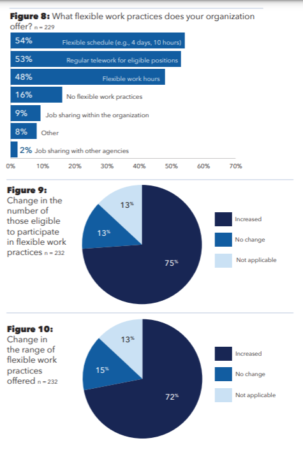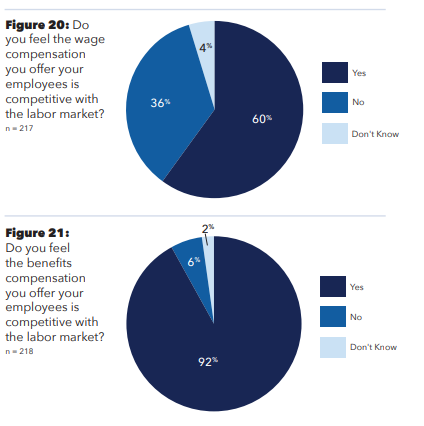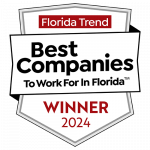Public sector employees make up 14.8% of the U.S. workforce, totaling 22.6M. The U.S. government is the number one employer in the nation. In comparison, Walmart is the top private employer with 2.2M employees . Understanding and addressing these top staffing challenges is paramount to our nation’s economic stability.
Top challenges facing state and local governments in the recruitment and retention of talented employees:
- Skills gap
- The Silver Tsunami: a retiring workforce
- Supporting hybrid and remote work
- Recruitment
Let’s take a deeper look at HR recruitment challenges with a skill gap and available talent and how robotics process automation (RPA) removes these barriers.
Supporting Hybrid and Remote Work
During the pandemic, the public sector made great strides to support remote work, in both eligibilities of employees who can participate or extend available flexible work practices.
The most common type of flexible work practice adopted, as shown in Figure 8, is flexible schedules (54%), with remote work coming in a close second (53%).

The debate remains whether this data reflects the reaction to quarantine or if this is a sustainable trend. Research suggests that for the attraction and retention of top talent, these practices must sustain.
The data says…
- 74% of workers say that a remote work option makes them less likely to leave a company.
- 62% of employees now expect their employers will allow them to work remotely moving forward.
What is the long-held myth that gives employers pause on offering this benefit? Productivity will suffer!
RPA can help by supporting employees working from home to improve productivity and service availability. The digital worker acts as a virtual assistant working alongside the remote employee, intuitively sensing when the employee might need support in handling a rule-based, repetitive activity.
Recruitment
Yes, RPA automates a host of tasks in your recruiting process, but that is not what we mean by RPA solves the recruiting challenge in the public sector.
Governments compete with private sector employers, often constrained by existing salary structures, budget processes, or other approvals. As a result, the share who feel their wage compensation is competitive with the labor market is just 60%. By comparison, with pensions more prevalent among public agencies than private, 92% rate their benefits offerings as competitive (see Figures 20 and 21).

What do you say in your hiring process today to get candidates excited about their role in government? Civic duty? Pension and benefits? Imagine describing to your next job applicant that, if hired, a virtual assistant will do the work they don’t want to do. They get to train and delegate to this assistant all repetitive, low-value work so the applicant can learn and thrive in more strategic work. You will teach them not only the skills of automation that are in high demand and provide soft-skill training that will help them rise through the ranks and inspire real change. Talk about civic duty!
In conclusion, bots intend to augment human worker roles for optimal work-effort outcomes, not replace them. A hybrid workforce allows employees to focus on the inherently human work (strategy, judgment, creativity, and empathy). Investing in RPA establishes a new way of working that maximizes the expertise of your employees, lower operational costs, and improve the employee experiences.
Learn more about how MCCi and RPA can support your organizational goals.
Sources:
SHRM, Hiring Challenges Confront Public-Sector Employers
Wikipedia, List of largest United States–based employers globally
Center for State and Local Government Excellence (SLGE), SURVEY: STATE AND LOCAL GOVERNMENT WORKFORCE 2021
Findstack, The Ultimate List Of Remote Work Statistics for 2021
Intuition, Remote Working Statistics You Need to Know in 2021


